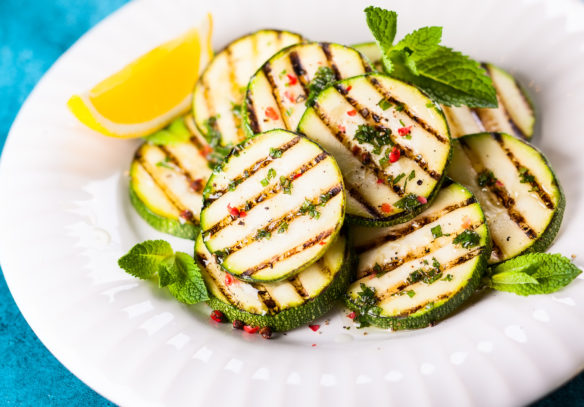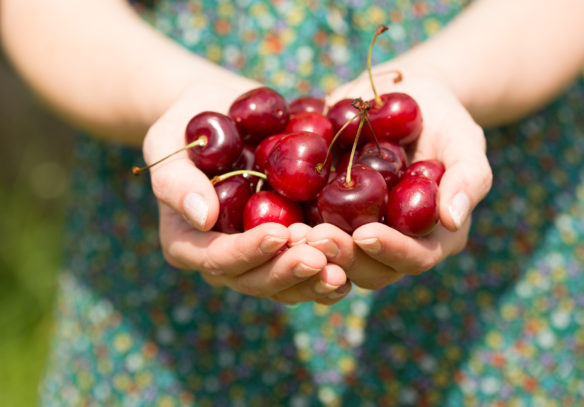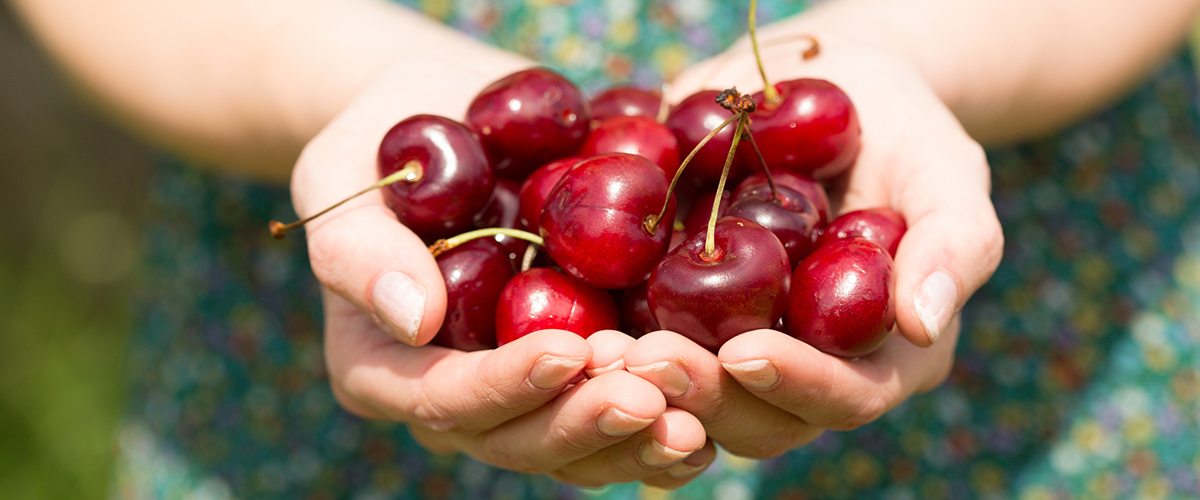Get them while they’re ripe. June is National Fresh Fruit and Vegetable Month and to celebrate, we’re sharing our favorite summer fruits and veggies and all of the reasons why they can help feed your potential. Enjoy them all season long with our quick tips and easy recipes as well as some fresh ideas from Aramark Lifeworks Chef, Dane Peterson.

Zucchini
Unlike spaghetti, butternut, and other winter squash, zucchini skin is thin and edible which makes them even easier to prep – no peeling required. Peterson is a fan of lightly pickling long, thin slices of zucchini and enjoying them on a Mediterranean-style grilled chicken sandwich with mesclun greens, tzatziki, heirloom tomato and feta cheese. He explains, “Zucchini is an example of a soft vegetable that can be cold pickled overnight to retain some of its crunch. Leaving the skin on will give it some color contrast and will not affect the texture.”
Avocado
Technically a fruit, avocados are right at home in sweet smoothies, frozen desserts, and brownies, as well as in crowd-pleasing guacamole. Creamy and full of healthy fats, they’re actually lower in fat and make a great healthy sub for mayo on sandwiches or butter in baking. Naturally cholesterol free, the healthy fats help your body absorb fat-soluble nutrients like vitamin D. Amp up your guacamole game with healthy add-ins like tomatoes, radishes, cucumbers, shallots or red onion, yellow or orange bell peppers, in addition to the quintessential lime juice, cilantro, salt and pepper.
Chicken, Avocado Salad Wrap Recipe
Blackberries
All the berries are in fine form during the summer, and blackberries are no exception. A cup of these antioxidant powerhouses is only 60 calories and provides half of the day’s recommended vitamin C along with seven grams of fiber. Blackberries can be stored for up to six days and should be washed just before enjoying. Enjoy them in a smoothie or a compote, but they’re also perfect finger food on their own.

Cherries
You may be familiar with the juicy, sweet, deep red Bing cherries that are widely available during the summer months. Another variety to try are delicately sweet Rainier cherries, which are a light golden color with a pink blush. Rainiers aren’t around as long, so get them while you can. They’re about 100 calories per cup (about 21 cherries) and a sweet way to get a good source of fiber and vitamin C. After de-seeding, try them mixed into yogurt, blended into a sauce to top grilled pork loin, or added to a farro salad.
Bell peppers
Whether green, red, orange, or yellow, bell peppers are crisp and sweet. A whole pepper is only 25 calories and provides 190 percent of the daily recommended amount of vitamin C, which helps our bodies absorbs iron from plant foods like spinach. This makes peppers and dark leafy greens a great nutritional combo in salads. Try large dicing them and combining with pineapple, onion, and mushrooms to make fruit and veggie kabobs that you can grill; stuff them with a whole grain salad; or chop them up and add to a salad or crudité platter.
Roasted Red Pepper & Mozzarella Ciabatta Recipe
Cantaloupe
The orange flesh is a giveaway that, like carrots, cantaloupe is an excellent source of the antioxidant vitamin A. On a hot summer day, simply slice a cantaloupe in half, scoop the seeds out and fill with whole grain granola and pumpkin seeds for a simple breakfast. To pick the perfect melon, look for round, symmetrical fruit that is heavy for its size and bruise-free. The stem should give to gentle pressure and the fruit should have a pleasant scent. To save space in your refrigerator, you can store uncut cantaloupe on your kitchen counters at room temperature for up to a week.
Watermelon
Watermelon is one of the juiciest summer fruits. Chef Peterson recommends a watermelon salad with mint, cilantro and a light lime vinaigrette sprinkled with cotija cheese, as a refreshing side salad on a hot summer day. “I also like to slice the rinds thin and pickle them for another occasion. I find the pickled rinds particularly delicious as a topping on barbacoa tacos.” For watermelon rind, the skin needs to be removed. The rind is very tough so Chef Peterson recommends a hot pickling by bringing pickling liquid to a boil and pouring over the rinds, allowing the liquid to cool and refrigerate for at least two weeks before consuming. The rinds will last for one month if refrigerated.
Cucumbers
Make every day feel like a spa day with cucumber water. Simply peel, slice or muddle, and add to water for a refreshing beverage. Even without the spa water, did you know cucumbers count toward your daily water intake? That’s because they’re 95 to 97 percent water themselves, making them perfect for the summer heat. A cup of cucumber slices is a mere 15 calories and an excellent add-in to smoothies, guacamole, salsas, and sandwiches. They’re also great simply with vinegar and black pepper, or cut into strips for dipping into hummus. Look for firm cucumbers that are heavy for their size.
Note: Since everyone’s health history and nutritional needs are so different, please make sure that you talk with your doctor and a registered dietitian to get advice about the diet and exercise plan that‘s right for you.
Note: Since everyone’s health history and nutritional needs are so different, please make sure that you talk with your doctor and a registered dietitian to get advice about the diet and exercise plan that‘s right for you.

